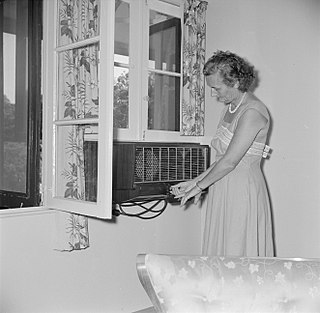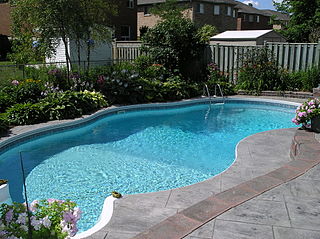
A natural disaster is the highly harmful impact on a society or community following a natural hazard event. Some examples of natural hazard events include: flooding, drought, earthquake, tropical cyclone, lightning, tsunami, volcanic activity, wildfire. A natural disaster can cause loss of life or damage property, and typically leaves economic damage in its wake. The severity of the damage depends on the affected population's resilience and on the infrastructure available. Scholars have been saying that the term natural disaster is unsuitable and should be abandoned. Instead, the simpler term disaster could be used, while also specifying the category of hazard. A disaster is a result of a natural or human-made hazard impacting a vulnerable community. It is the combination of the hazard along with exposure of a vulnerable society that results in a disaster.

Hyperthermia, also known simply as overheating, is a condition in which an individual's body temperature is elevated beyond normal due to failed thermoregulation. The person's body produces or absorbs more heat than it dissipates. When extreme temperature elevation occurs, it becomes a medical emergency requiring immediate treatment to prevent disability or death. Almost half a million deaths are recorded every year from hyperthermia.

A heat wave, sometimes described as extreme heat, is a period of abnormally hot weather. High humidity often accompanies heat waves. This is especially the case in oceanic climate countries. Definitions vary but are similar. A heat wave is usually measured relative to the usual climate in the area and to normal temperatures for the season. Temperatures that humans from a hotter climate consider normal, can be regarded as a heat wave in a cooler area. This would be the case if the warm temperatures are outside the normal climate pattern for that area. Heat waves have become more frequent, and more intense over land, across almost every area on Earth since the 1950s. This is due to climate change.
The July 1995 Chicago heat wave led to 739 heat-related deaths in Chicago over a period of five days. Most of the victims of the heat wave were elderly poor residents of the city, who did not have air conditioning, or had air conditioning but could not afford to turn it on, and did not open windows or sleep outside for fear of crime. The heat wave also heavily impacted the wider Midwestern region, with additional deaths in both St. Louis, Missouri and Milwaukee, Wisconsin.

A wave pool is a swimming pool in which there are artificially generated, large waves, similar to those of the ocean. Wave pools are often a major feature of water parks, both indoors and outdoors, as well as some leisure centres.

A splash pad or spray pool is a recreation area, often in a public park, for water play that has little or no standing water. This is said to eliminate the need for lifeguards or other supervision, as there is little risk of drowning.
A rather cool and uneventful summer along the East Coast of the United States changed abruptly when a ridge of high pressure centered off the coast of South Carolina strengthened in late July.

Cyclone mitigation encompasses the actions and planning taken before a tropical cyclone strikes to mitigate damage and injury from the storm. Knowledge of tropical cyclone impacts on an area help plan for future possibilities. Preparedness may involve preparations made by individuals as well as centralized efforts by governments or other organizations. Tracking storms during the tropical cyclone season helps individuals know current threats. Regional Specialized Meteorological Centers and Tropical Cyclone Warning Centers provide current information and forecasts to help individuals make the best decision possible.
An excessive heat warning is a notice issued by the National Weather Service of the United States within 12 hours of the heat index reaching one of two criteria levels. In most areas, a warning will be issued if there is a heat index of at least 105 °F (41 °C) for more than three hours per day for two consecutive days, or if the heat index is greater than 115 °F (46 °C) for any period of time.

The Summer 2006 North American heat wave was a severe heat wave that affected most of the United States and Canada, killing at least 225 people and bringing extreme heat to many locations. At least three died in Philadelphia, Arkansas, and Indiana. In Maryland, the state health officials reported that three people died of heat-related causes. Another heat related death was suspected in Chicago.

Air conditioning, often abbreviated as A/C (US) or air con (UK), is the process of removing heat from an enclosed space to achieve a more comfortable interior environment and in some cases also strictly controlling the humidity of internal air. Air conditioning can be achieved using a mechanical 'air conditioner' or by other methods, including passive cooling and ventilative cooling. Air conditioning is a member of a family of systems and techniques that provide heating, ventilation, and air conditioning (HVAC). Heat pumps are similar in many ways to air conditioners, but use a reversing valve to allow them both to heat and to cool an enclosed space.

A swimming pool, swimming bath, wading pool, paddling pool, or simply pool, is a structure designed to hold water to enable swimming or other leisure activities. Pools can be built into the ground or built above ground, and may be found as a feature aboard ocean-liners and cruise ships. In-ground pools are most commonly constructed from materials such as concrete, natural stone, metal, plastic, composite or fiberglass, and can be of a custom size and shape or built to a standardized size, the largest of which is the Olympic-size swimming pool.

A warming center is a short-term emergency shelter that operates when temperatures or a combination of precipitation, wind chill, wind and temperature become dangerously inclement. Their paramount purpose is the prevention of death and injury from exposure to the elements. This may include acute trauma from falling objects such as trees, or injury to extremities due to frostbite. A more prevalent emergency which warming centers seek to prevent is hypothermia, the risk for which is aggravated by factors such as age, alcohol consumption, and homelessness.
Passive survivability refers to a building's ability to maintain critical life-support conditions in the event of extended loss of power, heating fuel, or water. This idea proposes that designers should incorporate ways for a building to continue sheltering inhabitants for an extended period of time during and after a disaster situation, whether it be a storm that causes a power outage, a drought which limits water supply, or any other possible event.

Measles was declared eliminated from the United States in 2000 by the World Health Organization due to the success of vaccination efforts. However, it continues to be reintroduced by international travelers, and in recent years, anti-vaccination sentiment has allowed for the reemergence of measles outbreaks.

Sunset Park is a 24.5-acre (9.9 ha) public park in the neighborhood of Sunset Park, Brooklyn, New York City, between 41st and 44th Streets and 5th and 7th Avenues. The modern-day park contains a playground, recreation center, and pool. The recreation center and pool comprise the Sunset Play Center, which was designated as both an exterior and interior landmark by the New York City Landmarks Preservation Commission. The park is operated by the New York City Department of Parks and Recreation, also known as NYC Parks.

Syra Madad is an American pathogen preparedness expert and infectious disease epidemiologist. Madad is the Senior Director of the System-wide Special Pathogens Program at NYC Health + Hospitals where she is part of the executive leadership team which oversees New York City's response to the Coronavirus disease 2019 pandemic in the city's 11 public hospitals. She was featured in the Netflix documentary series Pandemic: How to Prevent an Outbreak and the Discovery Channel documentary The Vaccine: Conquering COVID.

The 2021 Western North America heat wave was an extreme heat wave that affected much of Western North America from late June through mid-July 2021. The heat wave affected Northern California, Idaho, Western Nevada, Oregon, and Washington in the United States, as well as British Columbia, and in its latter phase, Alberta, Manitoba, the Northwest Territories, Saskatchewan, and Yukon, all in Canada. It also affected inland regions of Central and Southern California, Northwestern and Southern Nevada and parts of Montana, though the temperature anomalies were not as extreme as in the regions farther north.

In 2022, several areas of the world experienced heat waves. Heat waves were especially notable in East Asia, the Indian subcontinent, Australia, western Europe, the United States, and southern South America. 2022 heat waves accounted for record-breaking temperatures and, in some regions, heat-related deaths. Heat waves were worsened by the effects of climate change, and they exacerbated droughts and wildfires.

Nude swimming in US indoor pools was common for men and boys from the late 1880s until the early 1970s, but rare for women and girls. For much of that time period, indoor pool use was primarily for physical education or athletic competition, not recreation. Male nude swimming had been customary in natural bodies of water, which was not viewed as a social problem until the 18th century. When the tradition of skinny-dipping in secluded spots had become more visible with urbanization, indoor pools were first built in the 19th century in part to address this issue by moving male swimming indoors. For the first decades of the 20th century, male nude swimming was associated with a trope of the "old swimming hole" as representing childhood innocence and adult masculinity. In their own classes, nudity was rare for girls based upon an assumption of modesty, but might include young children. Prepubescent boys might be nude in mixed-gender settings, including the presence of female staff, public competitions, and open houses for families.

















